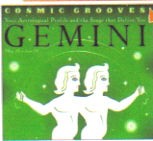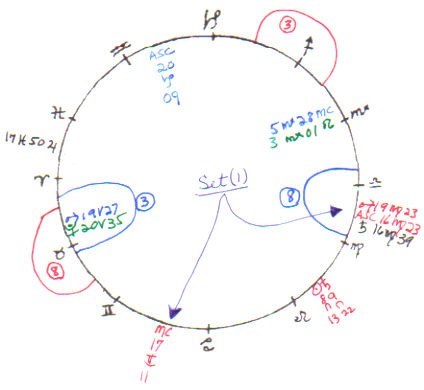
Your Astrological Profile and Songs
That Define You by Jane Hodges,
Illustrated by Michael Mabry,
Chronicle Books, September 2001
January 2012
Return to Home Page, Links to More Papers
Introduction
As I have stated in other twin papers, twin births are especially useful to this astrology. Why? Parents of twins usually know before birth they are having twins, so they pay especial attention to birth time. They do so because later those time differences are a conversation piece as well as forming part of the identity of the twins. So, birth time for twins is likely correct to the minute and the charts cast from them are also close to exact. Comparisons made between them are then based on correct astrology. That means twin births are especially good for testing a major principle of this astrological method, that planets on (≤2° orb) Angles are of primary importance in describing all our lives.
When one twin has a different sign on an Angle, their births are also useful for demonstrating the principle that astrological sets (aspects) ruling an Angle are of far more importance than those which do not.
Examples of this are shown in the samples below and in all of the twin papers on this site.
In this short paper we are going to identify the astrology that sponsored the SIDS death of one of these twins born in 1979. According to our data source, they were born fifteen minutes apart. I suspect, however, since those fifteen minutes were recorded as at the exact quarter hour, these are estimated times of birth and we cannot depend on the usual to-the-minute accuracy of twin births. This tentative conclusion is supported by the fact that these were Israeli births. Israel is nation peopled by many previous Europeans, where birth times were officially recorded to the nearest fifteen minutes.
It does not matter. Although we cannot depend on the absolute accuracy of either our birth/conception or our progressed Angles, at least the progression for death is only for 4 months, 27 days after birth, so that error cannot be great. The main reason it does not matter, however, is that the girl twin, who lived, has her pertinent conception Angles far below the set identified as the likely sponsor of the SIDS. The male twin, who died, on the other hand, has his conception Angles well within orb of the set.
All the biographical data on twins has been slim.
For twin No. 1 (#14760), the female twin who lived, Astrodatabank had:
Israeli first-born twin.
For twin No. 2 (#10733), the male twin who died, Astrodatabank had:
Israeli second-born twin. Died of SIDS on 10/30/1979 at approximately 6:58 a.m. [He was 4 months, 27 days old.]
I have written other papers on twins, that is, separating one twin from another using their astrology. Below are links to each of them :
Both Twins Died, One Ten Hours After Birth, The Other After 24 HoursOne Twin Normal, Other Twin with Myasthenia Gravis
One Twin Normal, Other Twin Retarded
One Twin Drowned, The Other Did Not
One Twin Normal, Other Twin Retarded, Example II
One Twin Accidental Death As Toddler, the Other Lived
Boy Twin Homosexual; His Sister Heterosexual
Twin Girls: One Twin Healthy, Employed, Heterosexual, the Other Sickly, Underemployed, and Lesbian
Boy Twin is Autistic While His Sister Is Not
Twin Differences: The Silent Twins, June and Jennifer Gibbons
One Twin Has the "Explorer Gene," The Other Does not
We should look at a description of the meaning of SIDS.
SIDS—Sudden Infant Death Syndrome
The following excerpt about SIDS is from mayclinic.com (1/5/2012):
Sudden infant death syndrome (SIDS) is the unexplained death, usually during sleep, of a seemingly healthy baby. Sudden infant death syndrome is sometimes called crib death.
The exact cause is unknown, but sudden infant death syndrome may be associated with abnormalities in the portion of an infant's brain that controls breathing [emphasis mine] and arousal from sleep. Although all babies are vulnerable, certain sleep environments have been linked to increased risk.
Perhaps the most important way to reduce the risk of sudden infant death syndrome is to place your baby on his or her back to sleep, on a firm crib mattress covered by a fitted sheet. Nothing else should go in the crib with your baby — no blanket, pillow, bumper pads or toys.
Although sudden infant death syndrome can strike any infant, researchers have identified have identified several factors that may increase a baby's risk. They include:
- Sex. Boy babies are more likely to die of SIDS.
- Age. Infants are most vulnerable during the second and third months of life.
- Race. For reasons that aren't well understood, black, American Indian or Eskimo infants are more likely to develop SIDS.
- Family history. Babies who've had siblings or cousins die of SIDS are at higher risk of SIDS themselves.
The next excerpt is from is from emedicinehealth.com (1/5/2012):
Sudden infant death syndrome (also known as SIDS) is defined as the sudden death of an infant younger than 1 year of age. If the child's death remains unexplained after a formal investigation into the circumstances of the death (including performance of a complete autopsy, examination of the death scene, and review of the clinical history), the death is then attributed to SIDS. Sudden infant death is a tragic event for any parent or caregiver.
SIDS is suspected when a previously healthy infant, usually younger than 6 months of age, is found dead in bed. In most cases, no sign of distress is identifiable. The baby typically feeds normally prior to being placed in bed to sleep. The infant is then discovered lifeless, without pulse or respiration. Cardiopulmonary resuscitation (CPR) may be initiated at the scene, but evidence shows a lack of beneficial effect from CPR. The cause of death remains unknown despite a careful review of the medical history, scene investigation, X-rays, and autopsy.
Astrological Method
And finally, before looking at the astrology for this tragic death, below I present information about this particular astrological method.
This astrology uses the sidereal positions of the planets based on the Fagan-Bradley’s SVP.
Harmonics are taken from the sidereal position of the planets. The Egyptian harmonic, discussed in the paper “About This Method” (see Home Page), is used.
”Lights” include suns, moons, and moons nodes.
This method uses only conjunctions, applying and separating squares, and oppositions. Orbs for planets with lights is 5°; without lights, about 2.5°. Orb for MC/planet or Asc/planet is 2°. Planets so related to each other are referred to as in the same “set.” A set, then, is two or more planets (or an Angle) connected to each other through conjunction, square, and opposition within the defined orbs. The set is more active if it contains a light, and less active without one. Learning to look in terms of “crosses” can be helpful in rapidly finding planets that are in the same set.
Because this approach uses both a birth and conception chart and they share the same axis, birth houses usually overlap different houses of the conception chart. These are called “house overlaps.” House overlaps play an important part in this astrology as investigation of the charts below (and in other papers) will show. Throughout this paper I use the convention when writing about house overlaps of putting the birth house first, then the conception house. So, for instance, a “5th/1st” overlap refers to an overlap of birth 5th house with conception 1st house in that order.
Birth planets (including their harmonics) rule only birth houses. Conception planets (including their harmonics) rule only conception houses.
For a more thorough explanation of this astrological approach, refer to this site’s papers entitled “About This Method” as well as the one entitled "Chart Reading Rules." There is also a link to the method paper at the bottom of every paper.
About This Method
Chart Reading Rules
In the partial charts shown below, birth planets and their harmonics are inside the circle. Conception planets and their harmonics are outside the circle. Conception sidereal planets are red; conception harmonic ones, black. Birth sidereal planets are blue; birth harmonic ones, green. Occasionally, because of space limitations, I have had to violate this inside/outside arrangement, but the color coding remain constant.
Abbreviations used are b = birth, c = conception, and t = transiting. Even though the harmonic used for each chart is always two more than the chart’s number, in these papers I write the harmonic number the same as the chart number. For example, the 5th chart uses the 7th harmonic, but I have established the convention of writing harmonic planets for the 5th chart as, e.g., c5 mars, which reads, “the harmonic for the 5th chart for conception mars.
Now we can look at those charts.
The Charts
For this paper, and for another SIDS paper following this one, the chart holding the suspected significator for SIDS was the 3rd chart.
With more cases of SIDS, it is possible other charts may also contain the significator. Especially if it references the 3rd house as part of its path. At any rate, right now I suspect the 3rd chart is involved because our 3rd charts are “harmonic enlargements” of our 3rd houses. Gemini is the natural ruler of the 3rd house. And mercury is the ruler of Gemini. Mercury is associated with thinking, speech, brain, mind, and many other things. Gemini, the sign of the twins, has long been associated with several anatomically paired phenomena, including the lungs.
So, an afflicted 3rd chart, with its association with brain and Gemini-lungs (respiration) clearly has potential as the holder of the significator for SIDS deaths.
The 3rd chart was also the main afflicted chart in the case of a boy born without a corpus collosum, another brain pathology. Here is the link to that chart, found in the paper on mental retardation: (Search for Ian)’s Astrology .
The Twins, Their Charts
The main difference between the 3rd charts of these twins occurs with their Angles—their birth Midheavens (MCs) and Ascendants (Ascs) and their conception MCs and Ascs. Midheavens change approximately 1° for every four minutes passage of time. Since birth and conception are functions of each other, we know their conception time, like birth time, is approximately fifteen minutes apart. Calculated out, their conception Midheavens are 3° 28’ apart. Here are the Angles and house cusps for the female twin (the boy’s are presented below his chart) : Placidus, Twin No. 1 (Female, Lived): C MC—13 Gemini 43, c11—16Can, c12—16Leo, C Asc—13 Vir 10, c2—11Lib, c3—12Sco B MC—1 Scorpio 50, b11—25Sco, b12—18Sag, B Asc—15Capricorn 30, b2—28Aqu, b3—4Ari
While the passage of fifteen minutes makes a relatively large difference in the Angles, it makes very little difference in the placement of the planets (showing the greatest difference in the placement of the harmonic moon in the 12th chart). So, the insides of the twins’ 3rd charts are essentially the same. Here I present only the pertinent planets from the boy’s chart.

Placidus, Twin No. 2 (Died): C MC—17 Gemini 11, c11—19Can, c12—20Leo, C Asc—16Virgo 23, c2—14Lib, c3—15Sco B MC—5 Scorpio 28, b11—29Sco, b12—22Sag, B Asc—20 Capricorn 09, b2—3Pis, b3—8Ari
Set (1) includes C MC and C Asc and mars/jupiter/saturn. Note that with both Angles having an orb of 2°, that places a lighted mars/saturn conjunct C Asc in b 8th house. Influences of rulers is as follows—c3 jupiter rules c 4th house and co-rules (17 of 32°) c 3rd, c3 saturn co-rules (19 of 32°) c 4th house. C mars rules c 3rd and 8th houses.
Being “on an Angle,” Set (1) is highly afflicted. Its additional influence to houses 3 (mind/brain), 4 (end of life), and 8 (transformations, including death), make it threatening, but not bad enough to preclude a live birth. That is because though technically on an Angle, the orb from mars to saturn, with the Angles closer to saturn, is too large to show us an Angular event.
Progressed Angles and lights turn Set (1) deadly. Here are all the influences on that 8th house Asc/mars/saturn, now called Set (2), on his date of death. Remember, the Angles also act as lights with a smaller orb (1° for progressions) than suns, moons, and nodes:
| Set (2) | C MC | 17 Gemini 11 | |
| progressed C MC | 18 Gemini 19 | ||
| C Asc | 16 Virgo 23 | ||
| c3 saturn | 16 Virgo 49 | co-ruler (19 of 32°) c 4th house | |
| progressed c3 sun | 16 Virgo 48 | ruler of c 12th house | |
| progressed C Asc | 17 Virgo 26 | ||
| progressed c3 saturn | 17 Virgo 34 | co-ruler (19 of 32°) c 4th house | |
| return sun | 18 Virgo 13 | ||
| c mars | 19 Virgo 23 | ruler of c 3rd and 8th houses |
Of course, birth/conception a little later would get us closer to that mars, but Set (2) contains so many lights we can now consider that the Asc/mars/saturn in Virgo is going to act like a truly Angular set, not just a technically Angular one.
By itself the following progression would not have caused his death, but with his other astrology, probably contributed somewhat to it. At 9 Leo 22 his progressed c sun (ruler of c 12th) is exactly conjunct his c saturn, co-ruler (19 of 32°) of c 4th house, at 9 Leo 22. Sun represents vitality, while saturn represents the suppression of it.
With C MC at 13 Gemini 43 and C Asc at 13 Virgo 10, his sister’s Angles, including the progressed ones, were not nearly close enough to the mars and saturn in Virgo to create an Angular set. Like her brother, she had the progressed harmonic sun and return sun lighting, shown in Set (2), lighting her mars and saturn. The set lacked Angular influence. In her chart it was part of the astrology that represented the death of her brother.
Since the literature states that boys are more liable to SIDS than girls, this boys progressed c3 sun (a male planet) may have also played into his death. But in this particular instance, we do not need to look for male lights to see why the boy died and the girl did not. Quite likely—but it remains to be proven—had the girl been born the later of the two, she would have died and her brother would have lived.
In their 7th charts both of them also had the following set:
| Set (3) | progressed c7 sun | 24 Libra 14 | coming from 14 Libra 00 at conception |
| c7 saturn | 24 Libra 17 | co-ruler (19 of 32°) c 4th house | |
| c7 mars | 24 Libra 30 | ruler of c 3rd and 8th houses |
Set (3) has no influence to an Angle. In her astrology it shows us more astrology representing the death (4th house) of her male (sun) sibling (3rd), especially since her return Asc at 23 Capricorn 51 gave the set an Angle. His return did not. In his chart it is a minor contributor to his death. Minor because his death would have occured without it.
Her astrology for the date of her brother's death also showed a progressed Angle/mars (pc7 mars, ruler of c 3rd and 8th houses, at 1 Scorpio 16 in early conjunction to her B MC at 1 Scorpio 50). Life after that gets darker for a while because she had progressed c7 saturn at 25 Libra 37 approaching her c mercury, ruler of both C Angles, at 26 Cancer 17.
Conclusion
Even if we cannot be exact about the Angles and their progressions for these twins, it is possible to see why the brother died while his sister lived.
But, do we know for sure that this astrology represents SIDS? Not really. All we know right now is it could represent SIDS, and reasonably so. What we do not know is how many other parts there might be to a SIDS significator. Perhaps even other charts are involved in defining the significator and separating it from other forms of brain dysfunction. Perhaps. It takes time, good fortune, helpful errors, and many other astrological incidents to build a full significator.
Further Work
A second set of SIDS twins, both with gender unknown, is discussed in the next paper. One twin died, the other lived. It will help in our definition of the SIDS significator. Here is the link: Twin Differences: One Twin Died of Sudden Infant Death Syndrome, the Other Twin Lived.

Twinflower, a member of the honeysuckle family
From Wildflowers of Michigan Field Guide, by Stan Tekiela
Data Acknowledgments
Letters following each name show the Rodden rating for data reliability.
Twin No. 1 (Female, #14760) (A)
Birth: 6/03/1979, 10:30 p.m. EET, Tel Aviv, Israel. From
Astrodatabank by Lois Rodden and Mark McDonough. Judith Gee quotes case in Modern Horoscopes, 4/1980
Conception:8/26/1978, 7:59:57 a.m. EET, Tel Aviv, Israel.
Twin No. 2 (Male, #14761) (A)
Birth: 6/03/1979, 10:45 p.m. EET, Tel Aviv, Israel. From
Astrodatabank by Lois Rodden and Mark McDonough. Judith Gee quotes case in Modern Horoscopes, 4/1980
Conception:8/26/1978, 8:14:53 a.m. EET, Tel Aviv, Israel.
About This Method
Return to Home Page
Empirically-Derived Rules for Reading Charts
About The Author
Contact the author at sleeweidner@yahoo.com